Floral Variation
Flower types
When examining a flower you will see that the flower parts can be arranged in different ways. Cutting a flower in longitudinally often helps to see the position of the ovary relative to the other flower parts.
Flower types are based on the position of the ovary in a flower.
There are three categories: hypogynous, perigynous, and epigynous.
| (a) hypogynous, if sepals, petals and stamens are attached to the receptacle below the ovary. The ovary in this case is said to be superior. Examples you may be familiar with include the flowers of tomato, tulip, and snapdragon. |
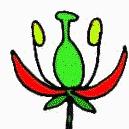 Illustration of a longitudinal section through a hypogynous flower. |
| (b) perigynous, if sepals, petals and stamens are fused at the base to form a cup-shaped structure called a hypanthium which is inserted beneath the ovary. The ovary in this case is still superior. You will see an example later in this section of the website (cherry, Prunus). |
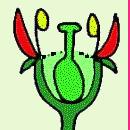 Illustration of a longitudinal section through a perigynous flower. |
| (c) epigynous, if sepals, petals and stamens arise from the top of the ovary, or from a hypanthium inserted above the ovary. The ovary of an epigynous flower is inferior. An example from lab was the daffodil. The daffodil has a hypanthium as well. |
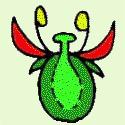 Illustration of a longitudinal section through an epigynous flower. |
Placentation
| Placentation refers to how the ovules are attached in the ovary. The cartoon below demonstrates the diversity of placentation types. |
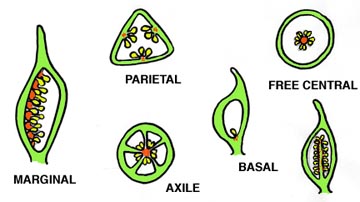 Placentation Types |
| We will examine two types of placentation. Parietal placentation is when the ovules are attached to the ovary wall, or to projections from the wall. |
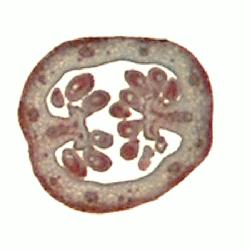 Cross-Section through an ovary with parietal placentation |
| Axile placentation (right) is when the ovules are attached to a central column. |
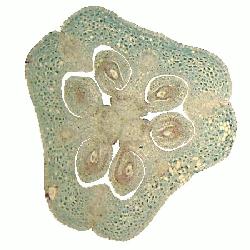 Cross-Section Through an Ovary With Axile Placentation |
Floral Variation
| The following pictures are to demonstrate some of the diversity in flower structure. You can apply the terms you have just learned. Variation does not only occur in the structure of individual flowers, but also their arrangement. Some flowers are solitary while others are clustered. The arrangement of flowers on a flower stalk is called the “inflorescence type”. There are many different finflorescence types which are beyond the scope of this course, but interesting none-the-less. |
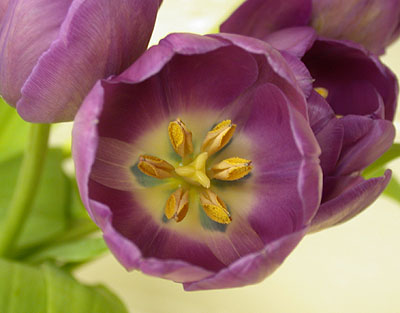 Tulipa (tulip) Flower, View from the Top |
| You can see in the photo to the right, the different flower parts. The ovary is superior. The flower is hypogynous. |
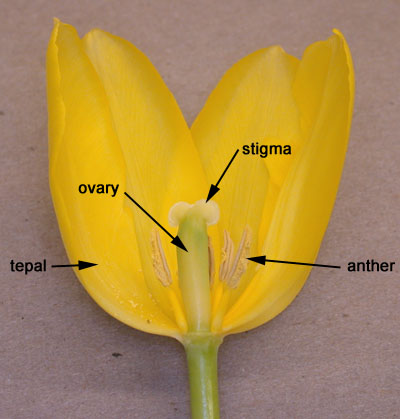 Tulip Flower Parts |
| The pistil of this flower has no style. |
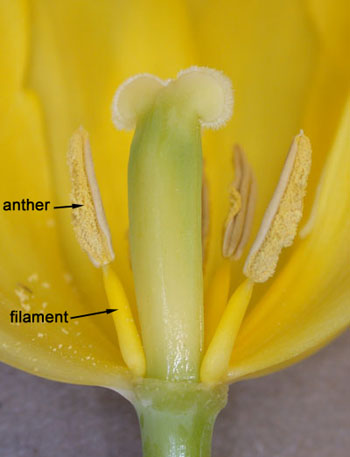 A closer look at the pistil and stamens |
| Mimulus (monkey face). The flower of this plant is bilaterally symmetric (= zygomorphic). |
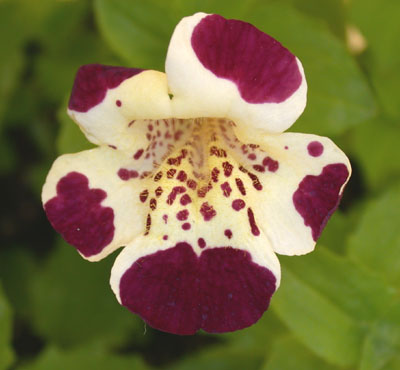 Mimulus – a zygomorphic flower |
| Antirrhinum (snapdragon) – another zygomorphic flower. |
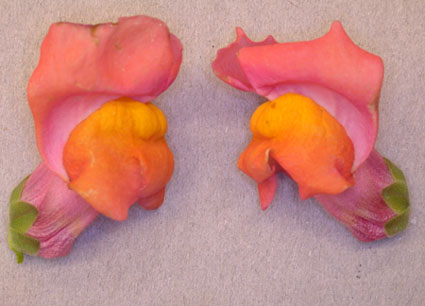 Snapdragon, in profile |
| To the right is a longitudinal section through the snapdragon flower. It has a superior ovary (hypogynous flower). |
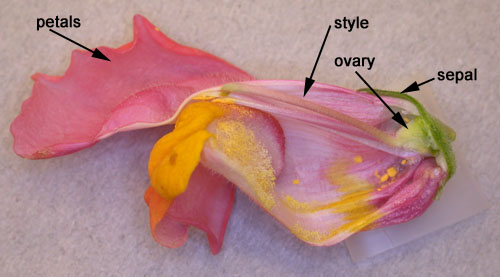 Snapdragon in longitudinal section |
| The cross-section through its ovary reveals that it has axile placentation. The pistil is made up of two carpels. You can see the many ovules. |
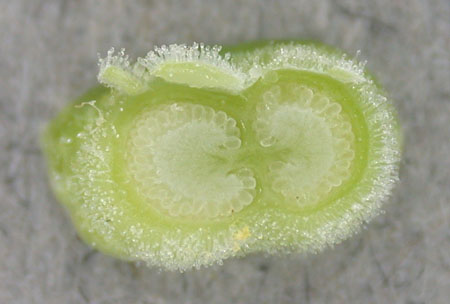 Cross Section through the ovary of a Snapdragon |
| To help you interpret the photo above, use the diagram to the right. |
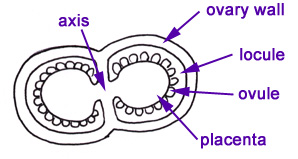 Diagram of the cross-section of the Snapdragon ovary |
| Narcissus (daffodil) is a favourite spring flower. |
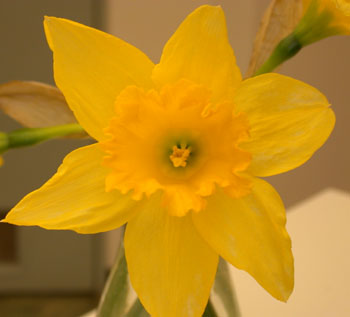 Daffodil Flower |
| Note the bulge at the base of the flower; that is the inferior ovary. |
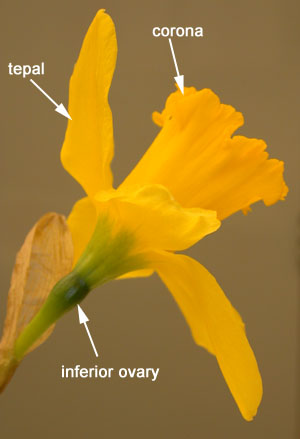 Daffodil Flower Parts |
| A longitudinal section through the flower confirms the inferior postition of the ovary. You can also see the other flower parts. |
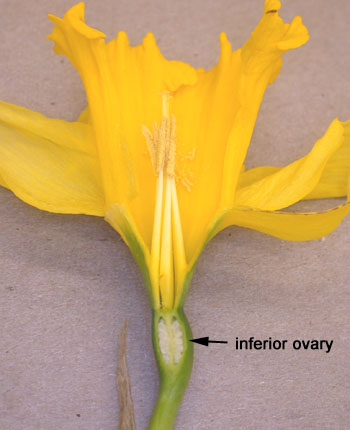 Longitudinal Section of a Daffodil Flower |
| The photo to the right is a a cross-section through the ovary of the daffodil demonstrating axile placentation (and that it is made up of three carpels). |
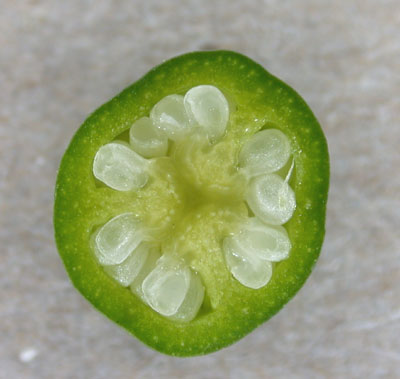 Ovary of a Daffodil Flower in Cross Section |
| Prunus (cherry) – Cherry blossom. |
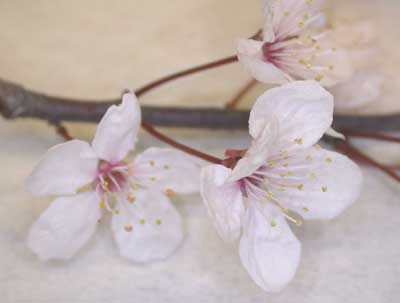 Branch from a Cherry Tree in Flower |
| Note the five petals and the numerous stamens. |
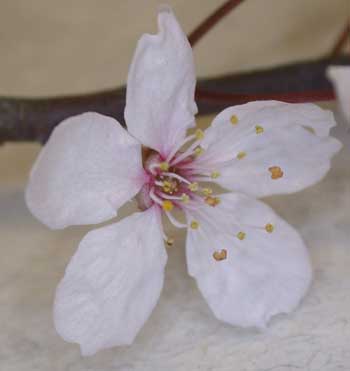 Close up of a Cherry Blossom |
| Note the small green sepals. |
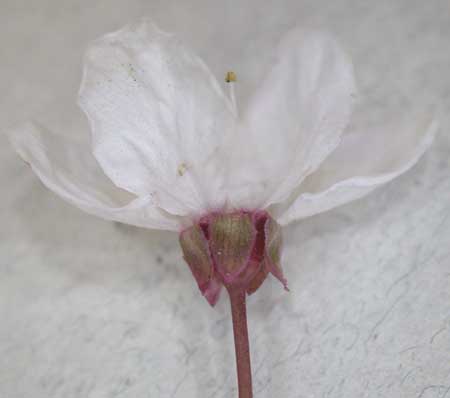 Side View of a Cherry Blossom |
| The longitudinal section reveals that the ovary is superior. The flower has a hypanthium (a cup-shaped structure made up of fused sepals, sepals, and stamens). |
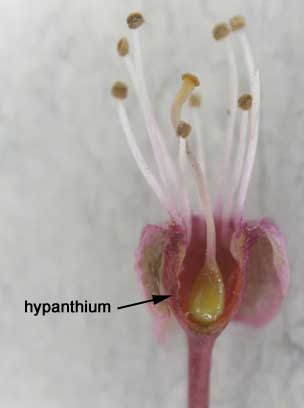 Longitudinal Section Through a Cherry Blossom with Petals Removed |
| Salix (willow) – You probably know this inflorescence as a pussy willow. This is a male catkin of willow (you can see the immature anthers). A catkin is an elongate inflorescence which is made up of either male or female flowers. Willows are therefore dieocious (male flowers and female flowers are on separate trees). |
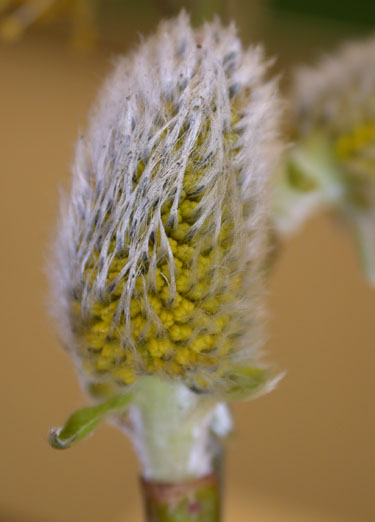 Willow Male inflorescence – a catkin |
| To the right, you can see the stamens mature and dangling from the catkin. There are two stamens per flower. The flower is very reduced. There are no visible petals or sepals, just lots of hairs. |
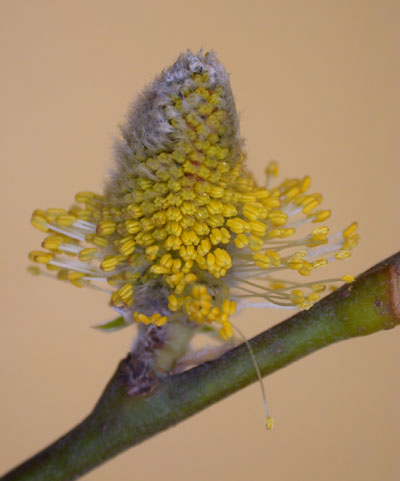 Maturing Male Catkin of Willow |
| This is another photo of a staminate catkin. Dangling stamens like this usually indicate that the plant is wind-pollinated. |
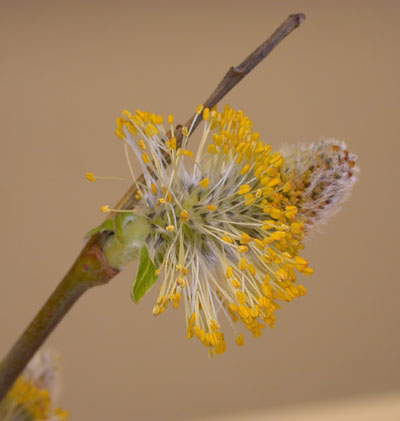 Make Catkin of Willow, almost ready for pollen release |
| Closer inspection of the inflorescence reveals the presence of nectaries. If it is wind pollinated then what is it doing with nectaries?? Could it perhaps have two ways in which pollination can occur? Both wind and insects? It would appear so! |
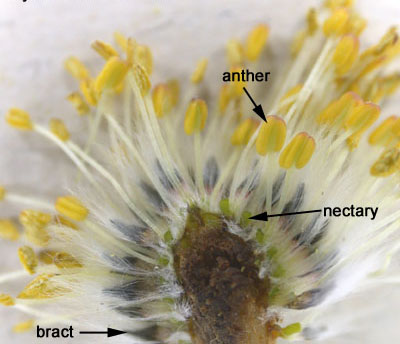 Male Catkin with Mature Stamens, almost ready to release pollen. |
| Here you can see an immature female catkin. You can see a small pistil. |
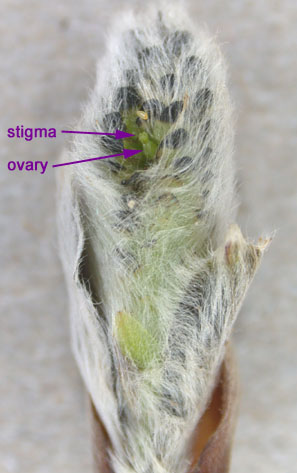 Female Catkin of Willow Demonstrating a Pistil |
| The fruit of Salix is not very appetizing. Each ovary develops into a capsule (dry type of fruit). |
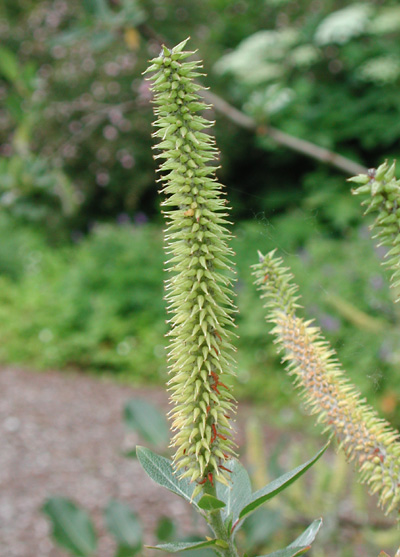 Immature Willow Fruits |
| The structure you just saw is actually made up of a number of fruits. This is a picture of a single capsule. A very small seed would be found at the base of each of those seed hairs. How do you think the seeds are dispersed?? |
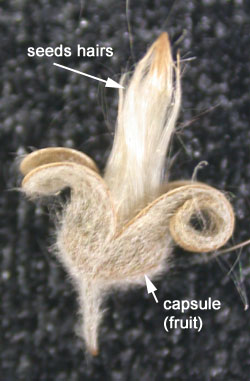 Mature Willow Fruits |
| Helianthus (sunflower) – is in the Asteraceae family (or sunflower family). It is the largest of the plant families and is characterized by having heads of small flowers. In this example you can see there are two types of flowers, Figure 3(dd). The flowers of the centre are very small. The ones that look like petals (to the un-botanical eye) are called ray flowers. |
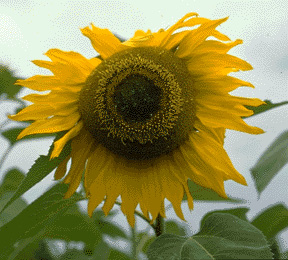 Sunflower Inflorescence |
| This is a longitudinal section through the inflorescence. You can see it is made up many flowers. |
 Longitudinal Section Through the Sunflower Inflorescence |
| Here is a closer look at the disk flowers. |
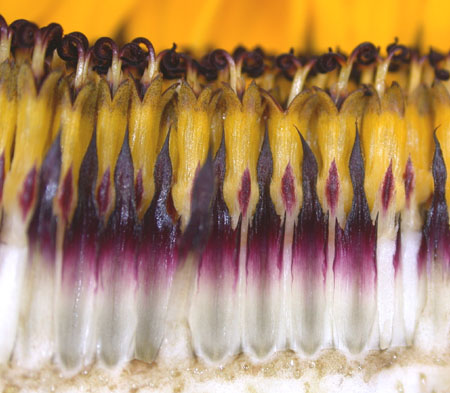 Close up of Disk Flowers |
| Here is a picture of a single disk flower. It is an epigynous flower. Note the petals which are fused into a tube. |
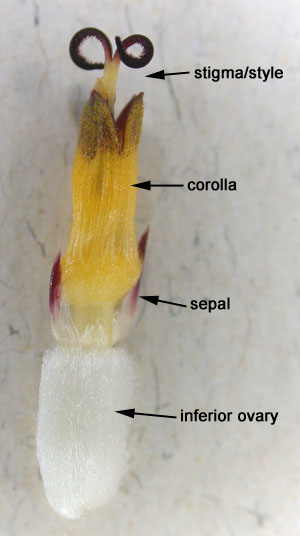 An Isolated Disk Flower of a Sunflower |
| Cosmos– a favourite garden composite flower (Asteraceae). |
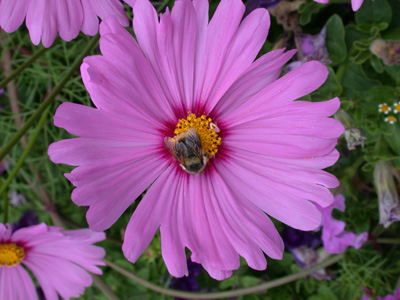 Cosmos Visited by a Pollinator |
| In this photo you can see that the disk flowers do not all mature at the same time. Those to the centre have not yet opened. Why would it be advantageous for a flower to have its flowers mature at different times? |
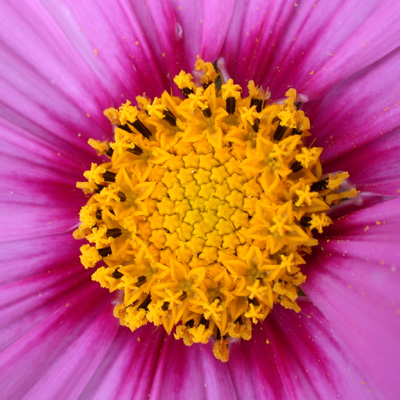
Close Up of Disk Flowers of Cosmos
|
| Aster-another favourite composite. |
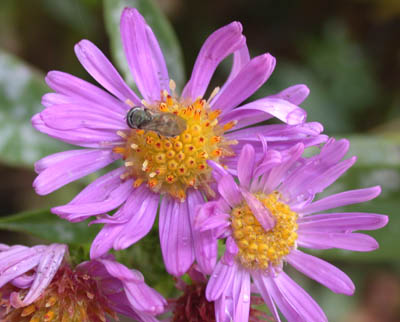 Aster visited by a pollinator |
| Here you can the mature disk flowers with the stamens clearly visible. The anthers are fused while the filaments are free. |
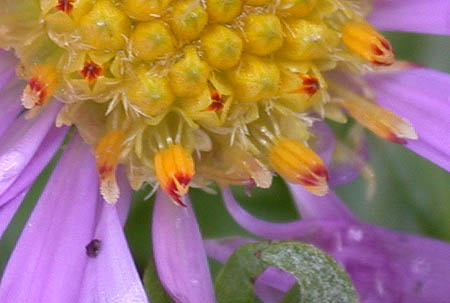 Aster Close Up of Disk Flowers Showing the Stamen |
| Would a few labels help? |
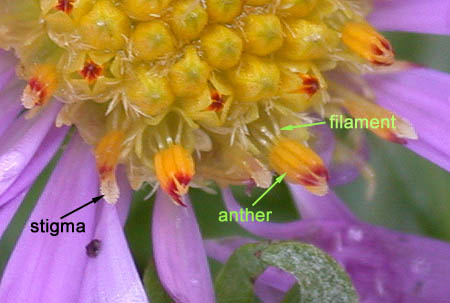 Close Up of Disk Flowers of Aster With Labels |
| Fragaria (Strawberry) – All of the examples we have looked so far have only one pistil per flower. Some flowers, such as this strawberry flower, have many pistils within each flower. You can see in Figure 3(mm) the many pistils in the centre of the flower with a ring of stamens to the outside. |
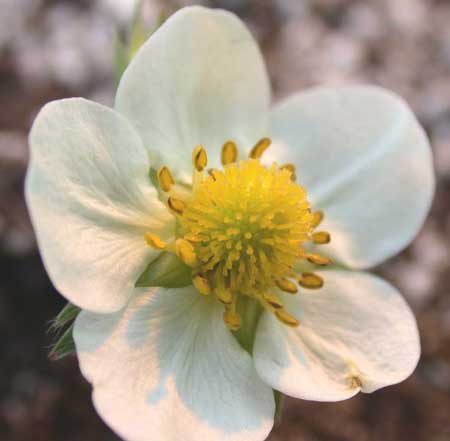
Strawberry – Flower Which Has Multiple Pistils in Each Flower
|
| In this figure you get a closer look at the pistils in the centre of the flower. The arrow is pointing to the stigma of a pistil. |
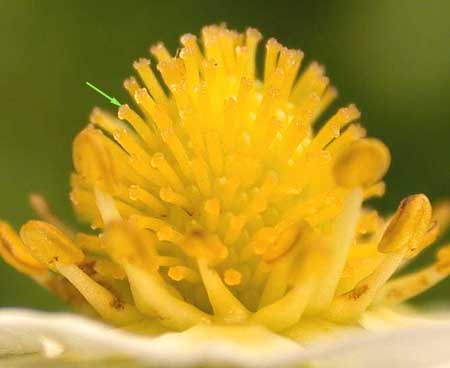 Pistils in a Strawberry Flower |
| The styles are attached to the base rather than to the top of the ovary. Later we will examine how this flower develops into a delicious strawberry. |
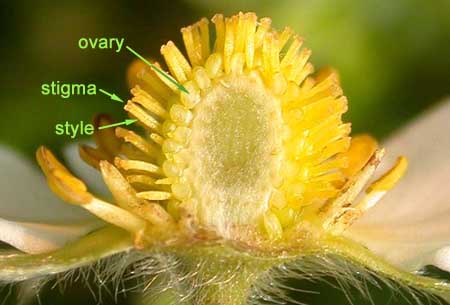 Longitudinal Section Through a Strawberry Flower |










































download video bokep
Thanks
OMG!! This was so helpful. THANKS A LOT .
Hi, I work for Oregon State Extension and work with Master Gardeners. I was wondering if I can use this information (floral parts) as supplemental information for the botany dissection virtual lab. I would like to give the link for those who would like to see it.
I am not a botanist and I find this quite helpful.
where to buy cbd oil or lotion in el cajon california
I join it